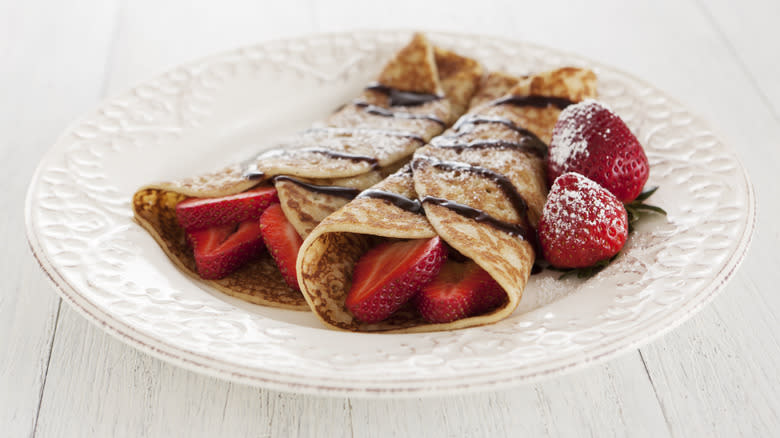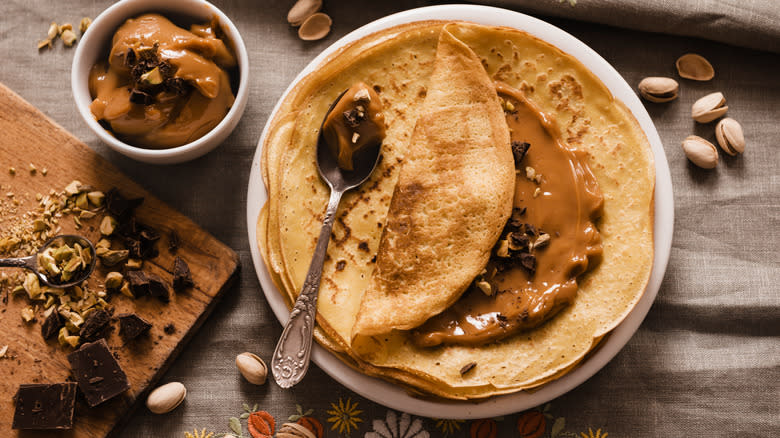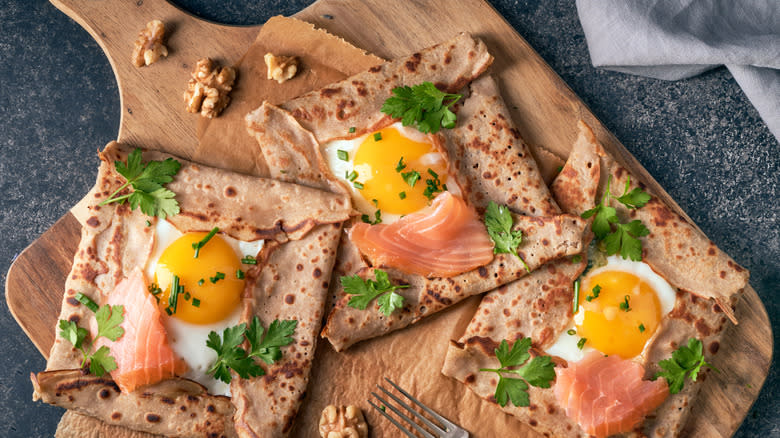For The Best Tasting Crepes, Make The Batter The Day Before

With sweet or savory fillings and toppings, crepes can create a foundation for any meal. The French have had this figured out for a long time. In fact, the country is credited with developing this particular style of ultra-thin, pliable pancake that has become a staple in kitchens worldwide. A combination of flour, eggs, and milk or water creates the basic recipe for crepes. At the same time, sweet or salty combinations are commonly also included to enhance the flavor and texture of these popular skillet delights. Unlike traditional American pancakes, crepes don't contain a leavening agent such as baking soda or baking powder, contributing to the desirably flat results.
There's more to the perfect crepe than the ingredient list, though. Technique has as much to do with creating a light, airy crepe as what goes into the batter. Regardless of the recipe, a smooth crepe requires thoroughly whisking the batter to remove flour lumps, incorporate air, and combine all the ingredients. Furthermore, allowing the batter to rest adequately is a widely accepted part of nurturing the development of a flawless crepe. This rest period serves several purposes, from maximizing flavors to controlling the amount of air in the crepe. The easiest way to achieve this delicious goal is to make the batter the day before and store it in the fridge until you're ready to use it.
Read more: French Cooking Tricks You Need In Your Life
Why You Should Let Crepe Batter Rest Before Use

For the best-tasting crepes, always make your batter ahead of time and allow it to sit for a minimum of 30 minutes. Many home and professional cooks recommend a longer rest, with most mentioning an overnight rest somewhere around 12 hours. Why does this rest period matter? Because it gives the flour adequate time to absorb the moisture in the mix, resulting in a more consistent batter, even cooking, and well-developed taste.
In addition, the gluten in the batter softens during the rest period, providing a softer texture to the cooked crepe. Without the downtime, your crepes may turn out gummy and dense rather than light. Giving your crepe batter a timeout before cooking will also enhance the flavor of the finished dish. When allowed to break down the gluten and properly incorporate all the ingredients, your crepe will move past the floury taste in favor of a creamy, buttery finish.
What To Do With Crepes

With your ingredients and technique mastered, what will you do with your pillows of perfection? Crepes are as versatile as bread or tortillas. There are myriad ways to put them to use as an appetizer, the centerpiece of your meal, or even as a dessert. For a savory crepe, toss in cooked chicken or turkey alongside broccoli or cauliflower. Then top it with your favorite cheese or bechamel sauce. Mushrooms, spinach, and asparagus are other wonderful additions. Ham and gruyere is a classic combination, but try appeasing your inner pork lover with the wonders of prosciutto, pancetta, crumbled bacon, speck, sausage, or guanciale instead. Combine French and Mexican flavors with shredded chicken, ground beef, pork, and accouterments like green chilies, sour cream, Mexican cheese, and guacamole.
On the other end of the spectrum, sweet crepes make a delicious snack or special breakfast. They pair perfectly with many fruits, like berries, peaches, and bananas. Top your decadent delight with whipped cream, layer in some Nutella, drizzle on syrup or incorporate jam. To impress, try making the famous French cake known as gateau de mille crepes. Whatever combination you decide on, stack it, roll it, or fold it, and your tasty treat is ready for instant consumption.
Read the original article on Daily Meal.

